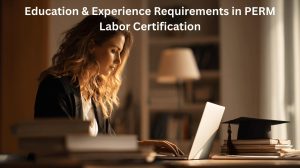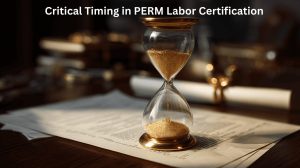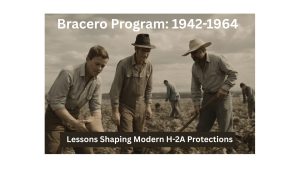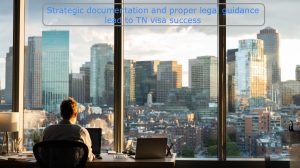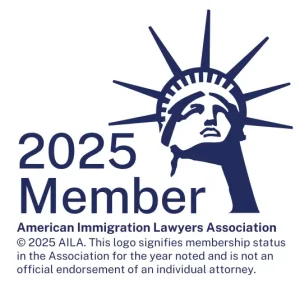When an employer sponsors a foreign worker for permanent residence through the PERM labor certification process, one of the most critical questions becomes: What qualifications can the worker use to meet the position’s requirements?
The answer depends significantly on whether we’re talking about education or experience – and where that qualification was obtained.
Department of Labor’s PERM program page
The Critical Distinction: Education vs. Experience
Under Department of Labor regulations, educational qualifications and work experience are treated very differently when gained during employment with the sponsoring employer.
Educational Qualifications: Generally Acceptable
An employee can use educational credentials earned while working for the sponsoring employer to meet PERM position requirements. This includes degrees, diplomas, and certificates obtained from accredited institutions during the employment relationship.
The regulation at 20 CFR § 656.17(i)(1) prohibits employers from requiring “skills not possessed by the alien at the time the application is filed.” This timing rule is the key: the beneficiary must actually possess the educational credential by the PERM filing date, but there’s no prohibition against obtaining that education while employed by the sponsoring company.
Why Education Is Treated Differently
Educational credentials are standardized, objective qualifications from accredited institutions. A Master’s degree is a Master’s degree regardless of when or where it was earned. The DOL views these as legitimate qualifications that exist independently of the employment relationship.
This policy creates valuable planning opportunities. An employee working toward an MBA, law degree, or other advanced credential can continue their education while the employer prepares the PERM case. Once the degree is conferred, the PERM application can be filed with the employee meeting all stated requirements.
Work Experience: The 50% Different Duties Rule
Experience gained with the sponsoring employer generally cannot be used to meet PERM requirements – with one important exception.
Under 20 CFR § 656.17(i)(3), experience with the sponsoring employer can only be counted if gained in a position that is “not substantially comparable” to the PERM position. The regulation defines “substantially comparable” as requiring performance of the same job duties more than 50% of the time.
Put simply: the two positions must differ by more than 50% in their job duties for the earlier experience to count toward PERM qualifications.
The DOL’s Reasoning
The Department of Labor’s concern is straightforward: if an employer hired someone without certain experience requirements, those requirements may not actually be “actual minimum requirements” for the position. The DOL wants to ensure employers aren’t creating artificially high requirements that U.S. workers couldn’t meet.
If the PERM position requires five years of experience but the beneficiary was hired with only two years, the DOL will question whether five years is truly the minimum needed for the job.
The Critical Timing Rule
Regardless of whether we’re discussing education or experience, one timing rule governs everything:
The beneficiary must meet ALL stated requirements by the date the PERM application (ETA Form 9089) is filed with the Department of Labor.
This is explicitly stated in 20 CFR § 656.17(i)(1), which prohibits requiring skills not possessed by the alien “at the time the application is filed.”
What This Means for Each Stage
Prevailing Wage Determination Filing: The beneficiary does NOT need to meet all requirements yet. The PWD establishes the wage level and can be filed while the employee is still completing education or gaining experience.
Recruitment Period: The beneficiary still does NOT need to meet all requirements. Recruitment can proceed while qualifications are being completed.
PERM Filing Date: The beneficiary MUST meet every stated requirement – education, experience, licenses, certifications – by this date. This is the critical milestone.
This timing structure allows strategic planning. Employers can initiate the PWD process while an employee is finishing their MBA or accumulating the final months of required experience, then file the PERM once all qualifications are actually obtained.
Licensing Requirements: A Special Consideration
Professional licenses occupy a unique position between education and experience requirements.
Under 20 CFR § 656.17(h), licensing requirements can ONLY be included if they are “legally required to perform the job duties.” Unlike education requirements, which employers have discretion to set, licenses can only be required when the law mandates them for that occupation.
Licenses Must Be Obtained Before PERM Filing
Like education, a professional license is an objective credential. An employee can obtain bar admission, medical licensure, or other professional licenses while working for the sponsoring employer – even if that work is in a different capacity (such as a paralegal working toward bar admission).
However, the license must be fully obtained and active by the PERM filing date. Unlike education where “substantially complete” might suffice in some contexts, licensing is binary: you’re either licensed or you’re not.
Practical Consideration: Many jurisdictions allow foreign-trained professionals to petition for permission to sit for licensing exams. An employee working as a paralegal who obtains U.S. bar admission during their employment meets licensing requirements for an attorney position – provided they hold independent work authorization allowing them to work as an attorney.
A Real-World Example
Consider this scenario: A law firm employs a foreign-trained attorney as a paralegal. The attorney has ten years of legal experience from their home country but isn’t admitted to practice in the United States.
While working as a paralegal, the employee petitions their state supreme court for permission to sit the bar exam, passes, and obtains admission to the state bar.
Can the Law Firm Sponsor This Employee for an Attorney Position?
Yes – with careful attention to the details:
Educational Requirement: The foreign law degree meets educational requirements (assuming it’s evaluated as equivalent to a U.S. law degree).
Licensing Requirement: The employee now holds an active U.S. bar license obtained while employed. This satisfies the licensing requirement since it’s held at PERM filing.
Experience Requirement: The firm can count the employee’s ten years practicing law in their home country. This experience was gained before joining the sponsoring employer, so it’s fully usable.
What About Paralegal Experience? The years working as a paralegal for this firm generally cannot be counted, even though paralegal work involves legal knowledge. Unless the firm can demonstrate the paralegal duties were more than 50% different from attorney duties, those years don’t count toward experience requirements.
The Timing Opportunity
This scenario also illustrates the timing planning opportunity. While the employee studies for the bar exam, the employer can:
- File the Prevailing Wage Determination (PWD)
- Plan and potentially conduct recruitment
- Wait for bar exam results and admission
Once the employee is formally admitted to the bar, the firm files the PERM with all requirements met. The employee’s work authorization (H-1B, L-1, EAD, or other status) determines whether they can immediately begin working as an attorney or must wait for adjustment of status.
The Job Availability Question
This example also raises an important strategic consideration that employers should understand: during the extended PERM processing period (currently 12-18 months or more), the attorney continues working. If the firm later promotes this attorney beyond the PERM position, questions about whether the PERM job remains “available to fill” may arise – but that’s a topic for another day.
Employer-Funded Education
One nuance worth noting: DOL regulation 20 CFR § 656.17(h)(4) states that the Department “will not consider any education or training obtained by the alien beneficiary at the employer’s expense unless the employer offers similar training to domestic worker applicants.”
In practice, this primarily addresses company-specific training programs rather than standard tuition reimbursement benefits. If an employer offers tuition reimbursement as a standard employee benefit available to all workers in similar positions, an employee’s use of that benefit to earn a degree doesn’t disqualify the credential.
The concern is narrow: preventing employers from providing special educational opportunities exclusively to foreign workers that aren’t available to U.S. worker applicants.
Strategic Planning Implications
Understanding these rules creates several planning opportunities:
Career Development Alignment: Employees can pursue advanced degrees knowing those credentials will support future PERM applications.
Timeline Management: Employers can initiate PWD requests while employees complete final educational requirements or accumulate needed experience.
Promotion Paths: When promoting employees internally, careful documentation of job duty changes is essential if relying on the 50% different duties exception.
Licensure Planning: Professional employees working toward U.S. licensure in fields like law, medicine, or accounting can pursue PERM once licensed, even if the license was obtained during employment.
Common Pitfalls to Avoid
Assuming “Almost Done” Is Enough: A degree must be fully conferred with official transcripts showing completion. “Expected graduation” or “defense scheduled” doesn’t meet the requirement at PERM filing.
Counting Employer Experience Without Analysis: Don’t assume years with the sponsoring employer count toward experience requirements without carefully analyzing whether job duties were more than 50% different.
Confusing Licensing and Education: While both can be obtained during employment, licensing requirements can only be stated when legally required for the occupation.
Missing the Filing Date Deadline: All requirements must be met by PERM filing – not by PWD filing or during recruitment, but by the actual ETA 9089 submission date.
Conclusion
The PERM process requires careful attention to qualification timing and sources. The key principles to remember:
- Educational credentials earned during employment with the sponsoring employer can be used
- Professional licenses obtained during employment can be used (when legally required)
- Experience with the sponsoring employer generally cannot be used unless gained in positions with more than 50% different job duties
- All qualifications must be possessed by the PERM filing date
- The Prevailing Wage Determination and recruitment can begin before qualifications are complete
- PERM regulations at 20 CFR Part 656
These rules create genuine planning opportunities for both employers and employees navigating the path to permanent residence. With proper timing and documentation, educational advancement during employment can support successful PERM applications.American Immigration Lawyers Association
This article provides general information about PERM labor certification requirements. Every case presents unique facts and circumstances. For specific guidance on your situation, consult with an experienced immigration attorney.
